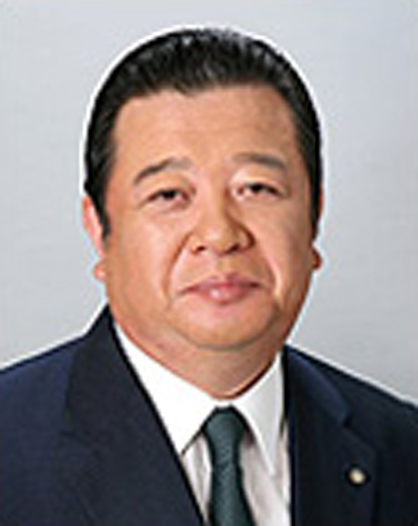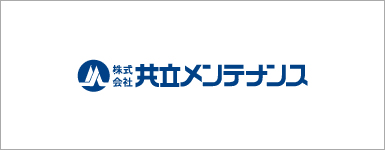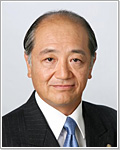| Kyoritsu Maintenance (9616) |
|
||||||||||||||
Company |
Kyoritsu Maintenance Co., Ltd. |
||
Code No. |
9616 |
||
Exchange |
TSE 1st Section |
||
Chairman |
Haruhisa Ishizuka |
||
President |
Mitsutaka Sato |
||
HQ Address |
Soto Kanda 2-18-8, Chiyoda-ku, Tokyo |
||
Year-end |
March |
||
URL |
|||
* Share price as of closing on January 11. Number of shares outstanding as of most recent quarter end, do not include treasury shares.
ROE and BPS are calculated by using actual amounts during or at the end of the previous term.
|
||||||||||||||||||||||||
|
|
* Estimates are those of the Company.
|
|
| Key Points |
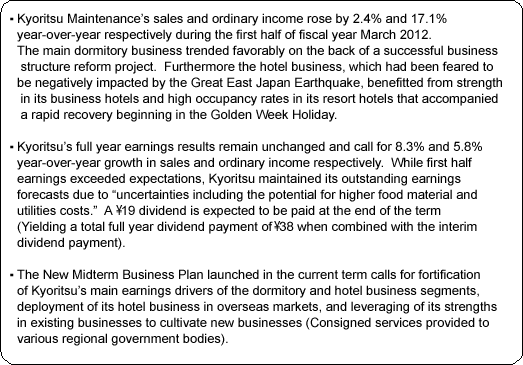 |
| Company Overview |
  |
| First Half Fiscal Year March 2012 Earnings Results |
 Sales and Ordinary Income Rise 2.4% and 17.1%
Sales rose by 2.4% year-over-year to ¥43.83 billion yen during the first half of the current term. The successful results of a business structure reform project allowed the dormitory business to trend favorably, business hotels to see high occupancy rates surpassing previous year' s levels, and resort hotels to see a rapid recovery in occupancy rates from Golden Week onwards. With the exception of the construction business, which normally sees a seasonal concentration of work in the second half of the fiscal year, all of Kyoritsu' s other businesses also recorded sales growth. With regards to profits, the launch of the "Public Kyoritsu Partnership" business (PKP: Jointly conducted consigned services business for regional government bodies) led to higher anticipatory investments (Caused profits to fall by ¥170 million), but higher occupancy rates and contributions from hotels opened during the previous term allowed profits of the hotel business segment to grow. Also increases in marginal profitability and contributions from increased fees from new large corporate dormitory contracts allowed profits of the dormitory business segment to grow. Consequently operating income rose by 18.0% year-over-year to ¥3.35 billion. While ¥250 million in valuation losses on marketable securities contributed to ¥360 million in total extraordinary losses, the disappearance of ¥690 million in losses resulting from the implementation of asset retirement obligation accounting in the previous term and ¥120 million in extraordinary income from the sale of fixed assets allowed extraordinary income to improve and net income to grow by a large margin. Capital investments rose by 56.7% year-over-year to ¥2.56 billion, while depreciation fell by 21.7% year-over-year to ¥1.66 billion.Furthermore, profits also exceeded estimates by a large margin due primarily to favorable trends in Kyoritsu' s hotel business. The business hotel operations, which saw higher than expected occupancy rates, contributed ¥250 million in profits, and the resort hotel operations, which saw a rapid recovery in occupancy rates from Golden Week onwards (During Golden Week, 8 of 18 facilities recorded 100% occupancy rates, and overall occupancy rates rose to 95.5% from 90.3% in the same period of the previous term.), contributed ¥500 million in profits, both exceeding expectations. In addition, the dormitory business and construction business segments saw larger than expected reductions in costs. (2) Business Segment Trends
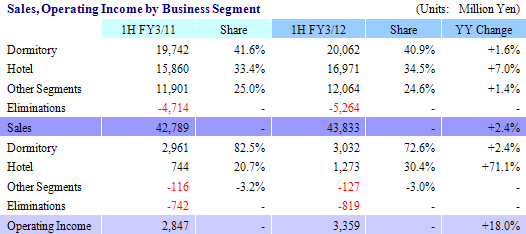 Dormitory Business
Sales and operating income rose by 1.6% and 2.4% year-over-year to ¥20.06 and ¥3.03 billion respectively. While cancelations of dormitory rooms by students from the earthquake affected regions arose, occupancy rates got off to a strong start by rising 2.4% points from the same period in the previous term to 95.3% at the start of the year. Furthermore fees from new contracts for new employee training facilities and for foreign student dormitories also boosted earnings. At the end of the first half of the current term, the number of contracted residents rose by 913 from same period in the previous term to 28,702.
 Hotel Business
Sales and operating income rose by 7.0% and 71.1% year-over-year to ¥16.97 and ¥1.27 billion respectively. The hotel business segment can be divided between the Dormy Inn (Business hotels) and resort hotel operations. During the first half occupancy rates at existing Dormy Inn facilities, which benefitted from earthquake disaster recovery related demand, exceeded the previous year' s levels. Specifically, strong improvements in occupancy rates were recorded at business hotel facilities in the earthquake affected Tohoku regions (Occupancy rates at Sendai Main rose from 76.8% to 97.3%, Sendai Annex from 82.3% to 97.4%, Sendai Station Front from 85.1% to 98.7%, and Koriyama from 78.1% to 88.7%). Furthermore, resort hotel operations, which had been negatively impacted by weaker demand due to restraint in travel in the wake of the earthquake, saw a rapid recovery in occupancy rates beginning in the Golden Week Holiday in early May with high levels of occupancy rates continuing throughout the peak summer resort demand season. During the first half of the current term, three new Dormy Inn facilities were opened ( "Natural Hot Spring Fugaku no Yu, Dormy Inn Mishima," "Natural Hot Spring Shirasagi no Yu, Dormy Inn Himeji," and "Natural Hot Spring Sodeminato, Dormy Inn PREMIUM Hakata Canal City Front" ).
 Other Businesses (Contracted Services, Food Services, Construction, Other)
In the contracted services business, improvements in occupancy rates in consigned building rental services contributed to higher sales and profits. And while profitability in the construction business improved, anticipatory investments of ¥170 million arising from the new PKP business led to a decline in profits. At the same time, weak demand and intensified pricing competition led to losses in the food services business.
(3) Financial Conditions and Cash Flow
  |
| Fiscal Year March 2012 Earnings Estimates |
 FY3/12 Earnings Estimates Remain Unchanged, Sales and Ordinary Income Expected to Rise by 8.3% and 5.8%
While earnings during the first half exceeded estimates, Kyoritsu has decided to maintain its outstanding earnings estimates due to "various uncertainties including potential increases in food material costs and public utility fees." Consequently sales are expected to rise by 8.3% year-over-year to ¥92.0 billion. The contribution from increased revenues arising from revisions in rent schedules in the contracted services business, and from the new PKP business are expected to allow other business sales to rise by 12.9% year-over-year. At the same time the dormitory and hotel business segments are expected to also trend favorably and grow by 3.3% and 5.0% year-over-year respectively. And while the factoring in of higher food material costs and utility fees are expected to contribute to increases in the ratio of cost of goods sold, and selling, general and administrative costs to sales, the higher level of sales are expected to offset these factors. Consequently operating income is expected to grow by 5.2% year-over-year to ¥4.85 billion. Capital investments are expected to rise by 54.8% year-over-year to ¥4.7 billion and depreciation to fall by 15.8% year-over-year to ¥3.6 billion. A yearend dividend of ¥19 is expected to be paid (Combined with the interim dividend for a total full year dividend of ¥38.).
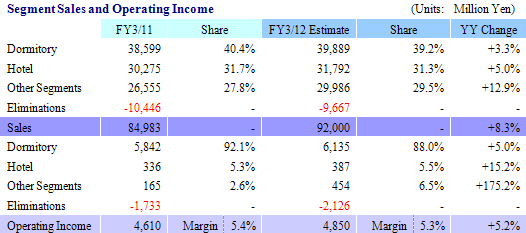 |
| New Midterm Business Plan: "Kyoritsu Value Up Plan!" (From FY3/12 to FY3/16) |
|
(1) New Midterm Business Plan Highlights
 (2) Growth Strategy Targets
  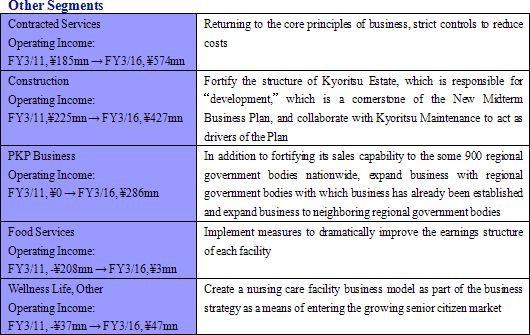 Public Kyoritsu Partnership (PKP) Business Prospects
The potential market for services that could be outsourced by 1,700 regional government bodies nationwide to private companies is estimated to be worth ¥2 trillion. Furthermore these regional government bodies currently retain 100,000 full time and 500,000 part time workers. Regional government bodies are now considering various means of reducing their operational costs (Including the reduction of staff numbers, facilitation of regional transportation networks, and facilitation or abandonment of third sector projects and public corporations), and Kyoritsu will provide services to match the needs of nationwide municipalities with populations of less than 300,000 for "comprehensive consignment" and municipalities with populations of over 300,000 for "large projects" and "partial consignment." The basic strategy for the PKP business is to provide integrated consigned services ranging from institutional design to operational consignment. It also covers the comprehensive consigned operations of transportation vehicles and other various operations. Kyoritsu expects the range of consigned services to include facility operation management (Including school cafeterias, libraries and other facilities), transportation vehicle operation management (School busses, government owned vehicles, and others), and regional facilities operation support (Public hot spring baths, lodging facilities and others). Track Record as of November 30, 2011
Kyoritsu' s consigned service track record includes work outsourced from 14 regional government bodies (Including comprehensive consigned services contracts with 2 regional government bodies: Yubetsucho, Hokkaido and Hidakagawacho, Wakayama)Consigned facility numbers: 36 facilities, 357 vehicles and staff 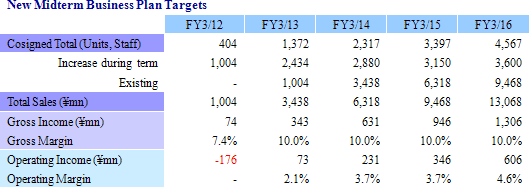 (3) New Midterm Business Plan Numerical Targets and Assumptions
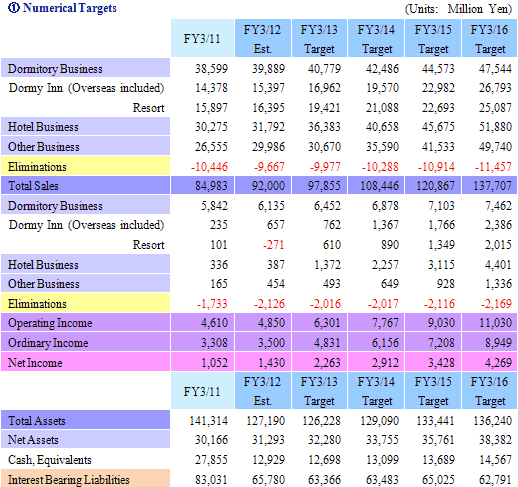   |
| Conclusions |
|
In the future, earnings are expected to expand on the back of growth through newly developed dormitory facilities, the implementation of a scrap and build strategy for existing facilities, and the start of the recovery phase of investments in the hotel business. Kyoritsu appears to have returned to its previous course of strong growth given the favorable start of the PKP business, its progress in cultivating other new businesses, and the impending start of its overseas expansion of its hotel business. Disclaimer
This report is intended solely for information purposes, and is not intended as a solicitation to invest in the shares of this company. The information and opinions contained within this report are based on data made publicly available by the Company, and comes from sources that we judge to be reliable. However we cannot guarantee the accuracy or completeness of the data. This report is not a guarantee of the accuracy, completeness or validity of said information and or opinions, nor do we bear any responsibility for the same. All rights pertaining to this report belong to Investment Bridge Co., Ltd., which may change the contents thereof at any time without prior notice. All investment decisions are the responsibility of the individual and should be made only after proper consideration.Copyright(C) 2012, All Rights Reserved by Investment Bridge Co., Ltd. |

